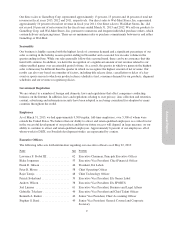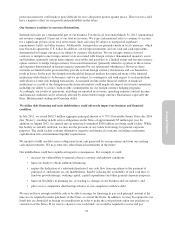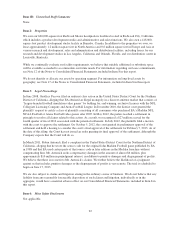Electronic Arts 2013 Annual Report Download - page 98
Download and view the complete annual report
Please find page 98 of the 2013 Electronic Arts annual report below. You can navigate through the pages in the report by either clicking on the pages listed below, or by using the keyword search tool below to find specific information within the annual report.the market. We have invested, and in the future may invest, in new business strategies, technologies, products,
and services. Such endeavors may involve significant risks and uncertainties, and no assurance can be given that
the technology we choose to adopt and the platforms, products and services that we pursue will be successful and
will not materially adversely affect our reputation, financial condition, and operating results.
Our product development usually starts with particular platforms and distribution methods in mind, and a range
of technical development goals that we hope to be able to achieve. We may not be able to achieve these goals, or
our competition may be able to achieve them more quickly and effectively than we can. In either case, our
products and services may be technologically inferior to our competitors’, less appealing to consumers, or both.
If we cannot achieve our technology goals within the original development schedule of our products and services,
then we may delay their release until these technology goals can be achieved, which may delay or reduce revenue
and increase our development expenses. Alternatively, we may increase the resources employed in research and
development in an attempt to accelerate our development of new technologies, either to preserve our product or
service launch schedule or to keep up with our competition, which would increase our development expenses.
We may also miss opportunities to adopt technology, or develop products and services for new platforms or
services that become popular with consumers, which could adversely affect our revenues. It may take significant
time and resources to shift our focus to such technologies or platforms, putting us at a competitive disadvantage.
We may experience outages and disruptions of our online services if we fail to maintain adequate
operational services, security and supporting infrastructure.
As we increase our online products and services, including our online commerce and content delivery system
Origin, we expect to continue to invest in technology services, hardware and software - including data centers,
network services, storage and database technologies - to support existing services and to introduce new products
and services including websites, ecommerce capabilities, online game communities and online game play
services. Launching high profile games and services, and creating the appropriate support for online business
initiatives is expensive and complex, and our execution could result in inefficiencies or operational failures, and
increased vulnerability to cyber attacks, which, in turn, could result in the inability of consumers to use our
products and services or otherwise diminish the quality of our products, services, and user experience. Cyber
attacks could include denial-of-service, brute force or validation attacks impacting service availability and
reliability; the exploitation of software vulnerabilities in Internet facing applications; social engineering of
system administrators (tricking company employees into releasing control of their systems to a hacker); the
introduction of malware into our systems with a view to steal confidential or proprietary data; or attempts to
hijack consumer account information. Cyber attacks of increasing sophistication may be difficult to detect and
could result in the theft of our intellectual property and consumer data, including personally identifiable
information. Operational failures or successful cyber attacks could result in damage to our reputation and loss of
current and potential users, subscribers, advertisers, and other business partners which could harm our business.
In addition, we could be adversely impacted by outages and disruptions in the online platforms of our key
business partners, who offer our products and services.
Our business could be adversely affected if our consumer protection and data privacy practices are not
seen as adequate or there are breaches of our security measures or unintended disclosures of our
consumer data.
There are several inherent risks to engaging in business online and directly with end consumers of our products
and services. As we conduct more transactions online directly with consumers, we may be the victim of
fraudulent transactions, including credit card fraud, which presents a risk to our revenues and potentially disrupts
service to our consumers. In addition, we are collecting and storing more consumer information, including
personal information and credit card information. We take measures to protect our consumer data from
unauthorized access or disclosure. However, it is possible that our security controls over consumer data may not
prevent the improper access or disclosure of personally identifiable information. A security breach that leads to
disclosure of consumer account information (including personally identifiable information) could harm our
reputation, compel us to comply with disparate breach notification laws in various jurisdictions and otherwise
subject us to liability under laws that protect personal data, resulting in increased costs or loss of revenue. A
14
























